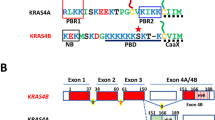Summary
The first exonic and its flanking regions of a ras-related gene in cultured erythrophoroma cells and normal liver of goldfish (Carassius auratus) were sequenced and their sequences compared. The two samples demonstrated identical sequences for the Alu I fragment of 245 nucleotides, of which 70 nucleotides might correspond to the 5′-upstream segment and 64 to the first intervening sequence, indicating that the predicted exonic region encodes from the 1st to the 37th amino acids from the N-terminal of mammalian ras protein. The length of the predicted first exon of goldfish was the same as that of mammals. There was a 5 nucleotide difference in this exonic region (length 111 nucleotides) from another previously determined ras-related sequence of normal goldfish. This difference was much smaller than that between any two of the three mammalian ras genes. Enhanced expression of ras gene was observed in erythrophoroma cells, although it was uncertain which ras gene was responsible for generation of the observed RNA.
Similar content being viewed by others
References
anders F, Schartl M, Barnekow A, anders A (1984) Xiphophorus as an in vivo model for studies on normal and defective control of oncogenes. Adv Cancer Res 42:191–275
Capon DJ, Chen EY, Levinson AD, Seeburg PH, Goeddel DV (1983a) Complete nucleotide sequences of the T24 human bladder carcinoma oncogene and its normal homologue. Nature 302:33–37
Capon DJ, Seeburg PH, McGrath JP, Hayflick JS, Edman U, Levinson AD, Geoddel DV (1983b) Activation of Ki-ras2 gene in human colon and lung carcinomas by two different point mutations. Nature 304:507–513
Dahr R, Nieto A, Koller R, Defeo-Jones D, Scolnick EM (1984) Nucleotide sequence of two ras related-genes isolated from the yeast Saccharomyces cerevisiae. Nucleic Acids Res 12:3611–3618
DeFeo-Jones D, Tachell K, Robinson LC, Sigal IS, Vass WC, Lowy DR, Scolnick EM (1985) Mammalian and yeast ras gene products: biological function in their heterologous system. Science 228:179–184
Harshbarger JH, Charles AM, Spero PM (1981) Collection and analysis of neoplasms in sub-homeothermic animals from a phyletic point of view. In: Dawe CJ (eds) Phyletic approaches to cancer. Japan Sci Soc Press, Tokyo, pp 357–384
Kataoka T, Powers S, Cameron S, Fasano O, Goldfarb M, Broach J, Wigler M (1985) Functional homology of mammalian and yeast Ras genes. Cell 40:19–26
Kimura M (1983) The neutral theory of molecular evolution. Cambridge University Press, Cambridge
Maniatis T, Fritsch EF, Sambrook J (1982) Molecular cloning: a laboratory manual. Cold Spring Harbor Laboratory, Cold Spring Harbor, New York
Manne V, Yamazaki S, Kung H-F (1984) Guanosine nucleotide binding by highly purified Ha-ras-encoded p21 protein produced in Escherichia coli. Proc Natl Acad Sci USA 81:6953–6957
Manne V, Bekesi E, Kung H-F (1985) Ha-ras proteins exhibit GTPase activity. Point mutations that activate Ha-ras gene products result in decreased GTPase activity. Proc Natl Acad Sci USA 82:376–380
Matsumoto J, Ishikawa T, Masahito P, Takayama S (1980) Permanent cell lines from erythrophoromas in goldfish (Carassius auratus). J Natl Cancer Inst 64:879–890
McGrath JP, Capon DJ, Smith DH, Chen EY, Seeburg PH, Goeddel DV, Levinson AD (1983) Structure and organization of the human Ki-ras proto-oncogene and a related processed pseudogene. Nature 304:501–506
McGrath JP, Capon DJ, Goeddel DV, Levinson AD (1984) Comparative biochemical properties of normal and activated human ras p21 protein. Nature 310:644–649
Messing J (1983) New M13 vectors for cloning. Methods Enzymol 101:20–78
Muller R, Wagner EF (1984) Differentiation of F9 teratocarcinoma stem cells after transfer of c-fos proto-oncogens. Nature 311:438–442
Natl Cancer Inst Monogr (1984) Hoover KL (ed) Use of small fish species in carcinogenicity testing. National Cancer Institute, Bethesda, Maryland, 65:1–409
Nemoto N, Kodama K, Tazawa A, Masahito P, Ishikawa T (1986) Extensive sequence homology of the goldfish ras gene to mammalian ras genes. Differentiation (in press)
Neuman-Silberberg FS, Schejter E, Hoffmann FM, Shilo B-Z (1984) The Drosophila ras oncogenes: structure and nucleotide sequence. Cell 37:1027–1033
Reymond CD, Gomer RH, Mehdy MC, Firtel RA (1984) Developmental regulation of a Dictyostelium gene encoding a protein homologous to mammalian ras protein. Cell 39:141–148
Shimizu K, Birnbaum D, Ruley MA, Fasano O, Suard Y, Edlund L, Taparowsky E, Goldfarb M, Wigler M (1983) Structure of the Ki-ras gene of the human lung carcinoma cell line Calu-1. Nature 304:497–500
Sukumar S, Notario V, Martin-Zanca D, Barbacid M (1983) Induction of mammary carcinomas in rats by nitroso-methylurea involves malignant activation of Ha-ras-1 locus by single point mutations. Nature 306:658–661
Sweet R, Yokoyama S, Kamata T, Feramisco J, Rosenberg M, Gross M (1984) The product of ras is a GTPase and the T24 oncogenic mutant is deficient in this activity. Nature 311:273–275
Takayama S, Ishikawa T, Masahito P, Matsumoto J (1981) Overview of biological characterization of tumors in fish. In: Dawe CJ (eds) Phyletic approaches to cancer. Japan Sci Soc Press, Tokyo, pp 3–17
Taparowsky E, Suard Y, Fasano O, Shimizu K, Goldfarb M, Wigler M (1982) Activation of the T24 bladder carcinoma transforming gene is linked to a single amino acid change. Nature 300:762–765
Taparowsky E, Shimizu K, Goldfarb M, Wigler M (1983) Structure and activation of the human N-ras gene. Cell 34:581–586
Van Beneden RJ, Watson DK, Chen TT, Lautenberger JA, Papas T (1986) Cellular myc(c-myc) in fish (rainbow trout): Its relationship to other vertebrate myc genes and to the transforming genes of the MC29 family of viruses. Proc Natl Acad Sci USA 83:3698–3702
Author information
Authors and Affiliations
Rights and permissions
About this article
Cite this article
Nemoto, N., Kodama, K., Tazawa, A. et al. Nucleotide sequence comparison of the predicted first exonic region of goldfish ras gene between normal and neoplastic tissues. J Cancer Res Clin Oncol 113, 56–60 (1987). https://doi.org/10.1007/BF00389967
Received:
Accepted:
Issue Date:
DOI: https://doi.org/10.1007/BF00389967




